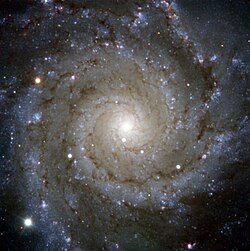M74
| 梅西耶 74 | |
|---|---|
 美丽的螺旋星系,M74 | |
| 观测资料(J2000 历元) | |
| 星座 | 双鱼座[1] |
| 赤经 | 01h 36m 41.8s[2] |
| 赤纬 | +15° 47′ 01″[2] |
| 红移 | 657 km/s[2] |
| 距离 | 30 ± 6 Mly[3] |
| 视星等 (V) | 10.0[2] |
| 特征 | |
| 类型 | SA(s)c[2] |
| 恒星数量 | 1000亿(1×1011) |
| 大小 | 95,000 ly (diameter)[4] |
| 角直径 (V) | 10′.5 × 9′.5[2] |
| 其他名称 | |
| NGC 628, UGC 1149, PGC 5974[2] | |
M74 (也称为NGC 628)位于星座双鱼座内,是一个正面朝向地球的螺旋星系,与地球的距离为3200万光年[5]。这个星系有两条明显的螺旋臂,因此被作为宏观螺旋星系的典型范例[6]。这个星系的低表面亮度,使它成为业馀天文学家最难观测的梅西耶天体之一[7][8]。然而,相对较大的视角大小和以正面朝向地球,使它成为专业天文学家研究螺旋臂和螺旋臂密度波的理想天体。估计M74拥有1,000亿颗恒星[5]。
历史
[编辑]M74是皮埃尔·梅香在1780年发现的。然后梅香将他的发现通知梅西耶,后者并将这个星系列入梅西耶天体 [8]
超新星
[编辑]已经在M74发现三颗超新星[2]:SN 2002ap[9]、SN 2003gd[10]和SN 2013ej。
SN 2002ap是距离在10百万秒差距以内,又是近几年相当少见的Ic型超新星(或是极超新星),因此吸引了相当大的注意[11][12][13]。这颗超新星已经被用来测试距离更遥远,类似Ic型超新星起源的理论[12],和超新星与伽玛射线暴之间关连性的理论[13]。
SN 2003gd是IIp型超新星[14]。II型超新星的亮度已经知道,所以它们可以用来精确的测量距离。使用SN 2003gd测得M74的距离是9.6 ± 2.8秒差距,或是31 ± 9 百万光年[3]。用最明亮的超巨星做为比较,测得的距离是7.7±1.7Mpc和9.6±2.2Mpc [3]。Ben E. K. Sugerman发现与SN 2003gd相关联的回光 —— 爆炸后出现本身的反射光[15]。只有少数的超新星发现过这种反射光。这种反射似乎是来自超新星爆炸之前扩散出去,类似板状云的尘埃壳层,可以用来确认星际尘埃的成分[15][16]。
星系群的资讯
[编辑]M74是M74星系群中最亮的成员,这个群组有5-7个星系,包括特殊的螺旋星系NGC 660和几个不规则星系 [17][18][19]。由于用不同的方法识别组织的成员,有不同的结果,因此只有全都确定的才被纳入群组[19],所以群组确实的数量仍是未知数。
恒星形成
[编辑]
疑似黑洞
[编辑]在2005年3月22日,钱德拉X射线天文台宣布[20]在M74观测到比中子星辐射更强的超亮X射线源(ULX,ultraluminous X-ray source),其周期约为2小时。估计它的质量是太阳的10,000倍,这是中等质量黑洞的一个指标。这是黑洞理论中的一种类型,其质量介于可能驻留在许多星系中心的超大质量黑洞和恒星黑洞之间。正因为这样,它们被认为不是由单一的超新星形成,但有可能是少量的恒星黑洞聚集组成的星团。这个X射线源在被鉴定后,称为CXOU J013651.1+154547。
业馀天文学观测资讯
[编辑]M74位于双鱼座η东北东方1.5°[7][8],是梅西耶天体中第二黯淡的(只有M91比他更暗淡)。除非天空够黑暗以及晴朗,否则很难找到它[8],所以在受到光污染的地点很难看见它[7]。这个天体比较适合使用低的放大倍率观赏,在高倍率下会因为过度扩散,多数人会因为太微弱反而看不见[8]。此外,在完全适应黑暗的场所,使用眼角馀光通常比较容易看见[7][8]。
相关条目
[编辑]参考资料
[编辑]- ^ R. W. Sinnott (编). The Complete New General Catalogue and Index Catalogue of Nebulae and Star Clusters by J. L. E. Dreyer. Sky Publishing Corporation / Cambridge University Press. 1988. ISBN 0-933346-51-4.
- ^ 2.0 2.1 2.2 2.3 2.4 2.5 2.6 2.7 NASA/IPAC Extragalactic Database. Results for NGC 628. [2006-08-12]. (原始内容存档于2019-02-17).
- ^ 3.0 3.1 3.2
M. A. Hendry; S. J. Smartt; J. R. Maund; A. Pastorello; L. Zampieri; S. Benetti; et al. A study of the Type II-P supernova 2003gd in M74. Monthly Notices of the Royal Astronomical Society. 2005, 359 (3): 906–926. Bibcode:2005MNRAS.359..906H. arXiv:astro-ph/0501341
 . doi:10.1111/j.1365-2966.2005.08928.x.
. doi:10.1111/j.1365-2966.2005.08928.x.
- ^ 存档副本. [2016-02-24]. (原始内容存档于2015-02-27).
- ^ 5.0 5.1 Astronomy Picture of the Day, M74: The Perfect Spiral. NASA. 2011-04-06 [2011-04-07]. (原始内容存档于2013-06-25).
- ^ A. Sandage; J. Bedke. Carnegie Atlas of Galaxies. Carnegie Institution of Washington. 1994. ISBN 0-87279-667-1.
- ^ 7.0 7.1 7.2 7.3 S. J. O'Meara. The Messier Objects. Cambridge University Press. 1998. ISBN 0-521-55332-6.
- ^ 8.0 8.1 8.2 8.3 8.4 8.5 K. G. Jones. Messier's Nebulae and Star Clusters 2nd. Cambridge: Cambridge University Press. 1991. ISBN 0-521-37079-5.
- ^ Nakano, S.; Hirose, Y.; Kushida, R.; Kushida, Y.; Li, W. Supernova 2002ap in M74. IAU Circular. 2002, 7810: 1. Bibcode:2002IAUC.7810....1N.
- ^ R. Evans; R. H. McNaught. Supernova 2003gd in M74. IAU Circular. 2003, 8150: 2. Bibcode:2003IAUC.8150....2E.
- ^ P. A. Mazzali; J. Deng; K. Maeda; K. Nomoto; H. Umeda; K. hatano; et al. The Type Ic Hypernova SN 2002ap. Astrophysical Journal. 2002, 572 (1): L61–L65. Bibcode:2002ApJ...572L..61M. doi:10.1086/341504.
- ^ 12.0 12.1
S. J. Smartt; P. M. Vreeswijk; E. Ramirez-Ruiz; G. F. Gilmore; W. P. S. Meikle; A. M. N. Ferguson; et al. On the Progenitor of the Type Ic Supernova 2002ap. Astrophysical Journal. 2002, 572 (2): L147–L151. Bibcode:2002ApJ...572L.147S. arXiv:astro-ph/0205241
 . doi:10.1086/341747.
. doi:10.1086/341747.
- ^ 13.0 13.1
A. Gal-Yam; E. O. Ofek; O. Shemmer. Supernova 2002ap: The first month. Monthly Notices of the Royal Astronomical Society Letters. 2002, 332 (4): L73–L77. Bibcode:2002MNRAS.332L..73G. arXiv:astro-ph/0204008
 . doi:10.1046/j.1365-8711.2002.05535.x.
. doi:10.1046/j.1365-8711.2002.05535.x.
- ^
S. D. Van Dyk; W. Li; A. V. Filippenko. On the Progenitor of the Type II-Plateau Supernova 2003gd in M74. Publications of the Astronomical Society of the Pacific. 2003, 115 (813): 1289–1295. Bibcode:2003PASP..115.1289V. arXiv:astro-ph/0307226
 . doi:10.1086/378308.
. doi:10.1086/378308.
- ^ 15.0 15.1
B. E. K. Sugerman. Discovery of a Light Echo from SN 2003gd. Astrophysical Journal Letters. 2005, 632 (1): L17–L20. Bibcode:2005ApJ...632L..17S. arXiv:astro-ph/0509009
 . doi:10.1086/497578.
. doi:10.1086/497578.
- ^
S. D. Van Dyk; W. Li; A. V. Filippenko. The Light Echo around Supernova 2003gd in Messier 74. Publications of the Astronomical Society of the Pacific. 2006, 118 (841): 351–357. Bibcode:2006PASP..118..351V. arXiv:astro-ph/0508684
 . doi:10.1086/500225.
. doi:10.1086/500225.
- ^ R. B. Tully. Nearby Galaxies Catalog. Cambridge University Press. 1988. ISBN 0-521-35299-1.
- ^ A. Garcia. General study of group membership. II – Determination of nearby groups. Astronomy and Astrophysics Supplement. 1993, 100: 47–90. Bibcode:1993A&AS..100...47G.
- ^ 19.0 19.1
G. Giuricin; C. Marinoni; L. Ceriani; A. Pisani. Nearby Optical Galaxies: Selection of the Sample and Identification of Groups. Astrophysical Journal. 2000, 543 (1): 178–194. Bibcode:2000ApJ...543..178G. arXiv:astro-ph/0001140
 . doi:10.1086/317070.
. doi:10.1086/317070.
- ^ Chandra :: Photo Album :: M74 :: 22 Mar 05. [2016-02-25]. (原始内容存档于2007-05-04).
外部链接
[编辑]- WikiSky上关于M74的内容:DSS2, SDSS, GALEX, IRAS, 氢α, X射线, 天文照片, 天图, 文章和图片
- Spiral Galaxy M74 @ SEDS Messier pages (页面存档备份,存于互联网档案馆)
- Barrena, Rafael; Crowther, Paul. M74 – Spiral Galaxy. Deep Sky Videos. Brady Haran. [2016-02-25]. (原始内容存档于2020-07-02).
